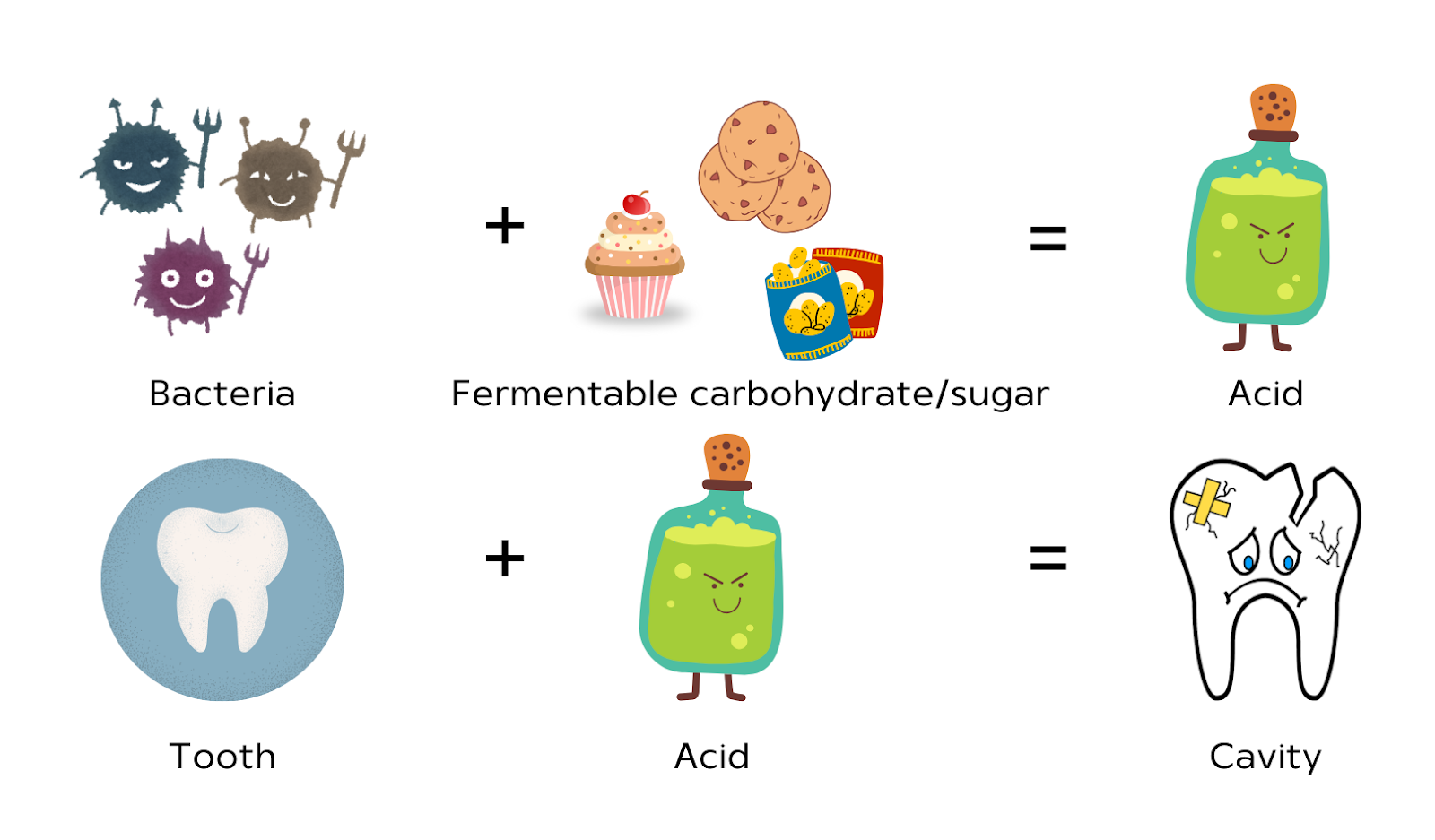Before we start thinking about how to care for our teeth and build healthy habits, it’s important to first understand how cavities form and the key factors that influence the process.
Below is a summary diagram!

To help solidify these concepts, let’s walk through the cavity process together.
Step 1: Eating or Drinking Sugars and Carbohydrates
Sugars in candy and cake are well known to be harmful to teeth. However, the key concept to emphasize is fermentable carbohydrates, which aren’t always sweet but can still harm teeth.
If the carbohydrate is simple, it can be easily broken down in the mouth into simple sugars (eg. glucose), which oral bacteria may use for energy. Examples include bread, crackers, and chips as well as the more obvious sweets like cakes and candy.
More complex carbohydrate (eg. those with more fiber and unrefined sugars), are harder to break down into simple sugars. Examples include fruits, vegetables and whole grains.
Step 2: Cavity-causing Bacteria Digest Simple Sugars and Produce Acid
Glucose, fructose and sucrose are the simple sugars that are digested by oral bacteria, producing lactic acid as a waste product.
How long does it take for lactic acid to be produced after eating carbohydrates? Less than 5 minutes.
Interestingly, not all mouths react the same way. Some people have a lot of plaque (and therefore bacteria) on their teeth but develop no cavities! Why? Because some oral bacteria, like Streptococcus mutans, produce an abundance of acid while other bacteria like Streptococcus rattus don’t.
Your personal composition and amount of oral bacteria determine how much acid is produced after eating carbohydrates.
The cool thing is that research in preventive dentistry has taken a new turn. If we introduce super oral bacteria that don’t produce acid into a cavity-prone mouth, there’s a chance they could take over! No acid means no cavities. Who knows? One day, dentists might even offer oral microbiome transplants in their offices!
Step 3: Acidity Below the Critical pH Dissolves Teeth
Once acidity in the mouth drops below a pH of 5.5, enamel - the hard outer shell of teeth - begins to dissolve.
Depending on what you eat, it can take 20-60 minutes for your mouth’s pH to neutralize (pH 7) and for the dissolving to stop.
Sticky foods like bread, gummies, granola bars and dried fruit prolong acidity longer than liquids such as juice.
Also, how often you snack on sugary foods and beverages matters. Let’s say you sip juice throughout the day or eat a cracker every 30 minutes, your mouth could remain acidic for most of the day!
What’s brilliant is if your teeth have daily exposure to fluoride, the fluoride is incorporated into the tooth crystal structurel!! The hydroxyapatite is replaced with fluorapatite, which is denser - similar to upgrading a house’s walls from straw to brick. This makes teeth more resistant to acid, lowering the critical pH for demineralization to 4.5 instead of 5.5.
Daily exposure to fluoride can be done by:
- Drinking fluoridated city tap water
- Brushing twice a day with fluoridated toothpaste
Step 4: Teeth Continue to Dissolve Until a Hole is Formed…THE CAVITY
In children, a cavity can develop in a matter of months. That’s why it’s possible for babies to get cavities!
Once a cavity reaches the pulp (the tooth’s core containing blood vessels and nerves), it can cause pain and infection in the surrounding tissues.
How long can it take for an initial cavity to reach the pulp in baby teeth? About 18 months, give or take 6 months.
Once a hole (cavitation) forms, the cavity will continue to progress. However, if the demineralization is caught in its early stages and the right minerals are present in a non-acidic environment, the lesion can remineralize and re-harden.
Now that you understand the ins and outs of how cavities develop, check out my other blogs for ways to interrupt different steps of the cavity process and maintain a healthier mouth!





